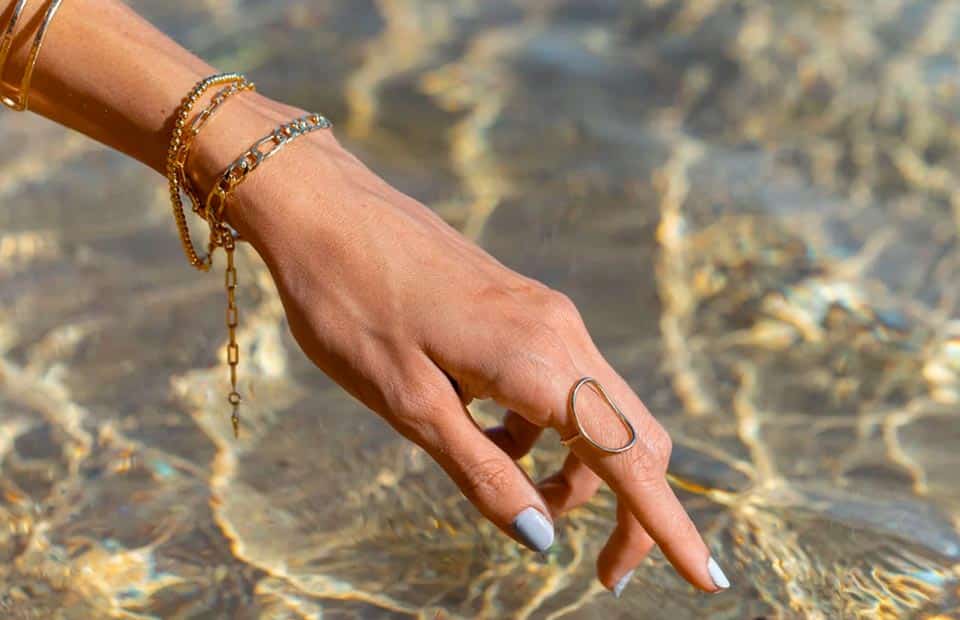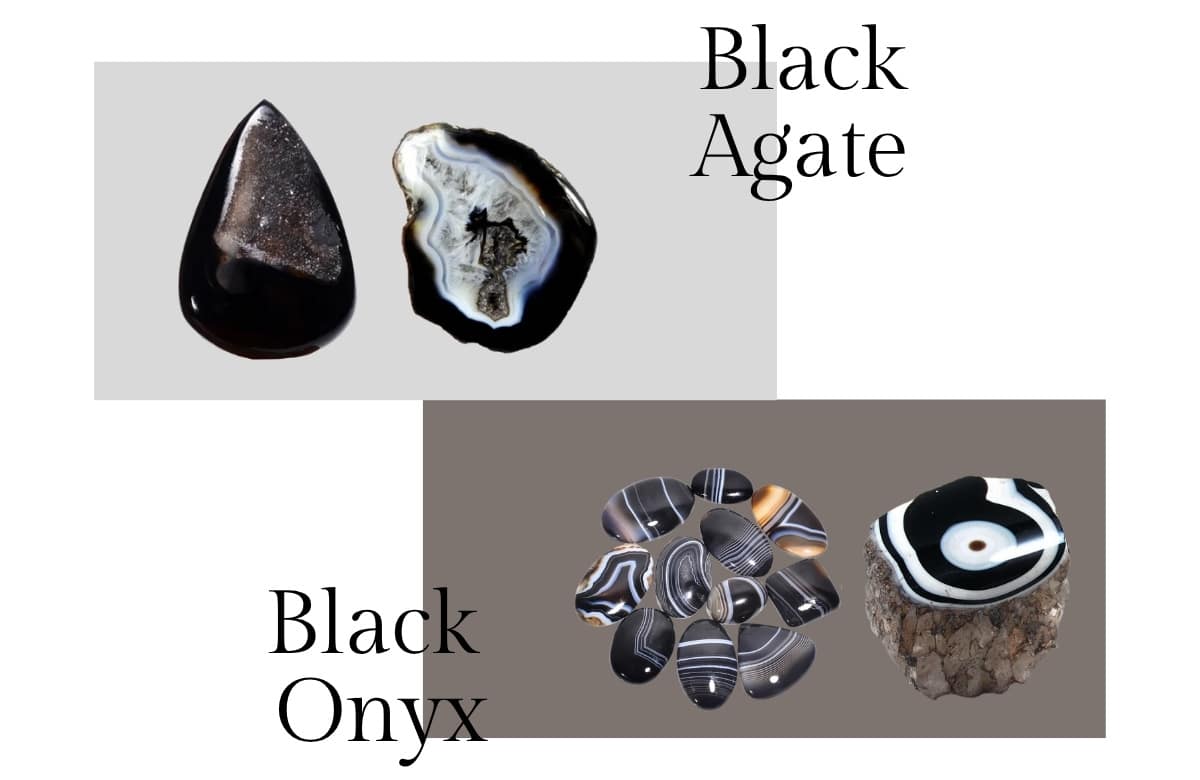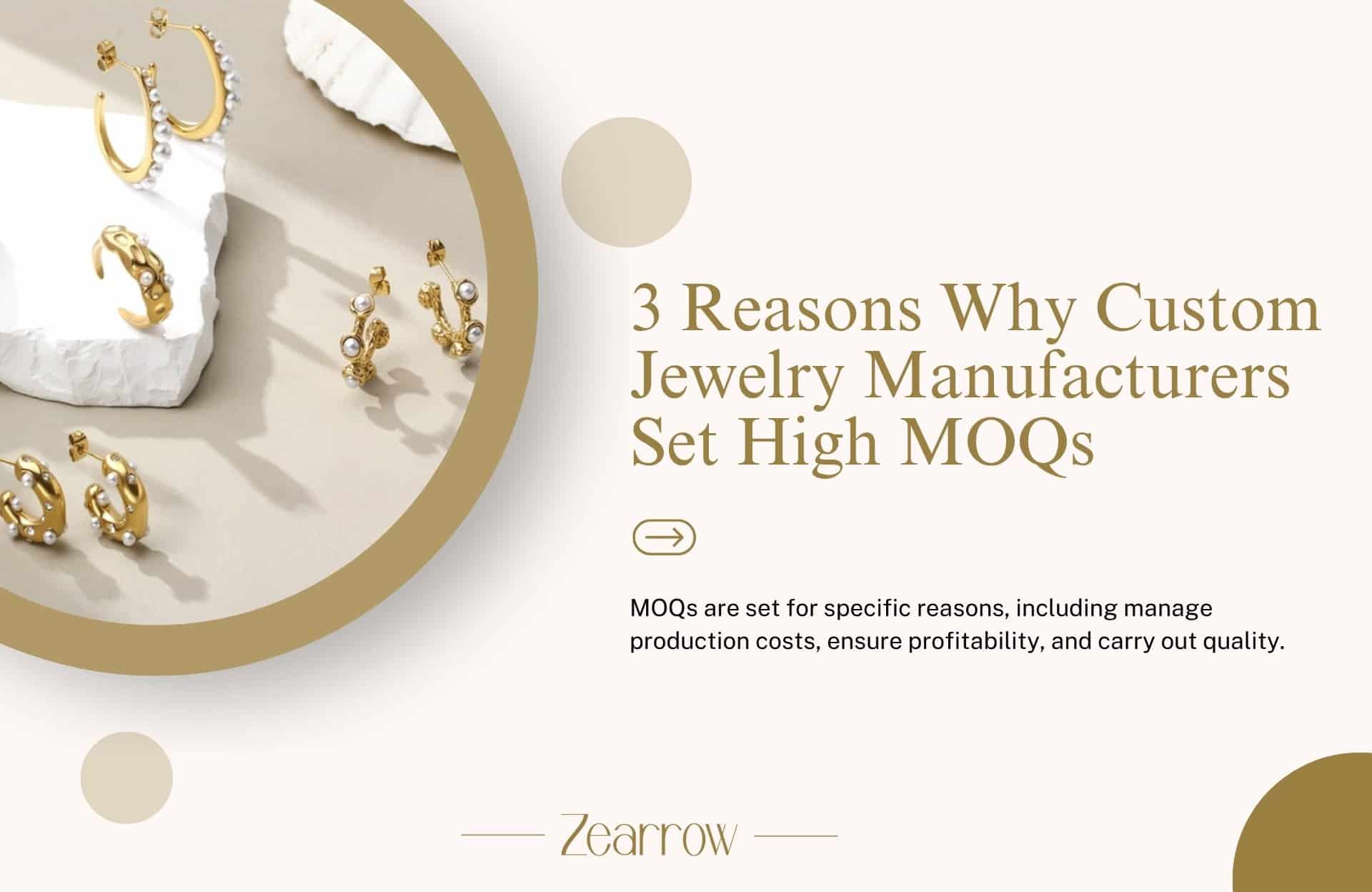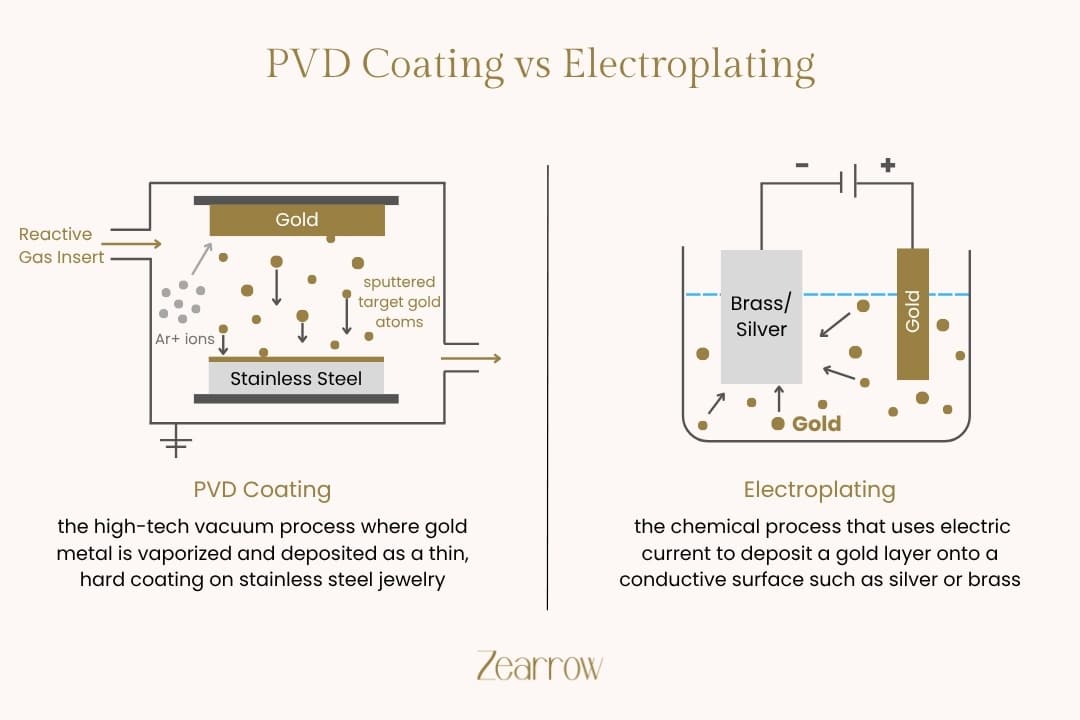The aftermath of the enjoyable seaside experience is that your jewelry might be damaged in the process, especially if it’s made with a material that cannot withstand the ocean.
Even if your jewelry is waterproof, it might not be able to withstand the salt content from sea water, thereby reducing the brilliance and enchanting appearance of the jewelry. Hence, knowing the type of jewelry to use when going to the beach is very important.

In this guide, we will enlighten you on the various types of jewelry that can survive salt water, allowing you to enjoy your next ocean dive without worries.
Does Salt Water Ruin Jewelry?
Saltwater contains salt and several minerals, such as magnesium, sodium chloride, and calcium, which can ruin certain types of jewelry. Salt and these minerals are harsh and capable of tarnishing the overall look of the jewelry, which is why it’s important to use a salt-water-resistant piece when going to the ocean.
These are some of the effects of salt water coming in contact with your jewelry:
- Corrosion: The constituents of salt water can accelerate the corrosion of some types of metals, particularly those that are not resistant to corrosion, such as iron, copper, aluminum, brass, and bronze. Thus, if your jewelry is made of any of these metals, you risk corroding it in the ocean. The ending effect is discoloration and degradation of the jewelry.
- Damage to Gemstones: Some gemstones, especially man-made stones like pearls, opals, turquoise, coral, and amber are more likely to spoil in salt water than others. Also, natural gemstones like diamonds and sapphires can be damaged if they are treated with elements that compromise their strength. This results in discoloration and weakening of the stone structure over time.
- Abrasion: Amongst the many components of salt water are tiny particles like sand and sediment, which can as well damage jewelry pieces, particularly those with intricate or hollow designs. Sand can be trapped inside, resulting in the scratching or loosening of gemstones.
Is it OK to Wear 14K Gold in the Ocean?
Pure gold because of its softness is not suitable for making jewelry pieces that can be worn daily. Hence a professional custom jewelry manufacturer mixes metals with pure gold to produce more durable pieces. However, the more metal components in a jewelry, the less authenticity of the pure gold. This means it won’t shine as bright and elegant as real gold.
14K gold is a mixture of 58.5% pure gold and 41.5% other metals, such as copper, zinc, silver, and nickel. It’s a very popular choice in the fashion and beauty industry because it creates a balance between durability and attractiveness.
Interestingly, salty ocean water has little to no effect on pure gold. But most of the alloyed metals are prone to salt water corrosion. Among the metals added, copper is usually the most vulnerable to corrosion. Therefore, the more copper in your 14K gold, the more risky it is in the ocean.
Can You Wear 18K Gold in the Ocean?
Just like 14K gold, 18K gold is a composition of pure gold with other metals. But it’s made up of 75% real gold and 25% metals. This alloying process increases the strength and durability of the gold while maintaining its luxurious look.
18K contains more real gold, which makes it able to survive in the ocean than 14K. However, the remaining 25% that is made of other metals, puts the jewelry at the risk of being tarnished and dull.
Generally, 14K and 18K gold jewelry are advised not to be worn in the ocean. However, 18K gold has more chance of surviving the harsh effects of the ocean than 14K gold.
Is Sterling Silver OK in Salt Water?
Just like pure gold, real silver is soft and prone to bending, but barely get affected by salt water. To enhance its strength and durability, silver is alloyed with other metals, resulting in the term “sterling silver.”
Sterling silver is composed of 92.5% real silver and 7.5% other metals, majorly copper. While copper is prone to corrosion, the larger percentage of pure silver in the composition makes sterling silver capable of withstanding extreme conditions in the ocean. But sterling silver is not 100% safe from salt water, it can darken sooner than normal after being soaked in saltwater for a while.
Can Stainless Steel Jewelry Go in the Ocean?
Stainless steel is a mixture of many elements, like iron, nickel, and chromium. While the major component is iron, every stainless steel jewelry contains at least 10.5% chromium, which acts as a protective layer on the piece to prevent corrosion. The chromium reacts with oxygen to form a thin, protective oxide layer on the surface, making stainless steel more durable and capable of surviving in salt water for a short period of time.
But in general, stainless steel jewelry is not able to withstand LONG-TIME being in saltwater.
What Jewelry is Safe to Wear in the Ocean?
There are many types of jewelry made with different materials, but only a few can be worn in the ocean without excessive negative effects. They are sterling silver, gold-filled, solid gold, and platinum. They will be discussed below:
Sterling Silver Jewelry
Sterling silver is an alloy of 92.5% fine silver and 7.5% copper. Sometimes, it’s called 925 sterling silver for short, indicating its composition ratio. Fine silver (also called pure or real silver) is a soft metal, hence it dents and scratches easily. But when mixed with copper, it becomes harder and more durable to withstand the downsides of the ocean.
Fine silver is the shiniest metal and it’s even more reflective than gold. Then, to make sterling silver, it’s mixed with copper, which is also a reflective metal, resulting in a super shiny piece. Real sterling silver jewelry comes with a 925 stamp, expressing the percentage of pure silver.
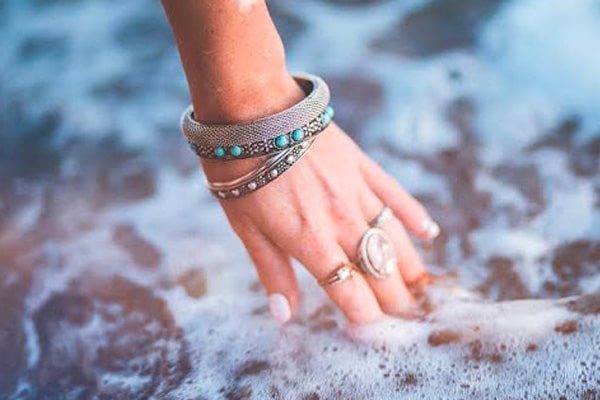
As mentioned earlier, sterling silver is made of silver and copper, and these two metals don’t rust. However, they tend to corrode when exposed to saltwater for a very long time. But with proper care and maintenance, they last long.
The better side to this is that sterling silver is inexpensive compared to some other metals like platinum, especially since pure silver and copper are not difficult to find. So, even in the case that your jewelry is tarnished, you can easily get another without breaking the bank.
Gold-Filled Jewelry
If you’ve ever wished to get pure gold jewelry, but don’t seem to understand the expensive price tag, gold-filled jewelry is the best solution. Gold-filled jewelry is a better all-rounder alternative to pure gold without breaking the bank.
Unlike sterling silver jewelry, gold-filled jewelry is not composed of alloyed materials. Rather, it’s made by heating and pressure-bonding a layer of pure gold on a base metal like brass. This transfers the characteristics and resistance of the gold to the base metal. The gold alloy can be bonded to one or both surfaces of the brass.

While it may seem as pure gold on the outside, it is harder, more durable, and less expensive, making it a better option. Also, it has high resistance to tarnishing and scratch, allowing you to wear it in the ocean.
Generally, gold-filled jewelry is mandated to have at least 5% or 1/20 pure gold by weight. With this, your piece will create a striking balance between beauty and durability. While it’s designed to withstand harsh conditions like salt water, it still radiates elegance and compliments your outfit for any occasion.
Solid Gold Jewelry
Solid gold is sometimes referred to as pure gold, but they are different. Solid gold is a combination of pure gold with other metals, but pure gold is completely real gold. There are different grades of gold measured by Karatage (K). They are 12K, 14K, 18K, 22K, and 24K. While 12K to 22K are composed of a percentage of pure gold and other metals, 24K is completely pure gold. Thus, 12K – 22K are solid gold, while 24K is real gold.
12K contains 50% pure gold and 50% other metals. 14K contains 58.5% pure gold and other metals, 18K contains 75% gold and 25% other metals, 22K contains 91.7% pure gold and 8.3% other metals, and 24K contains 100% pure gold.
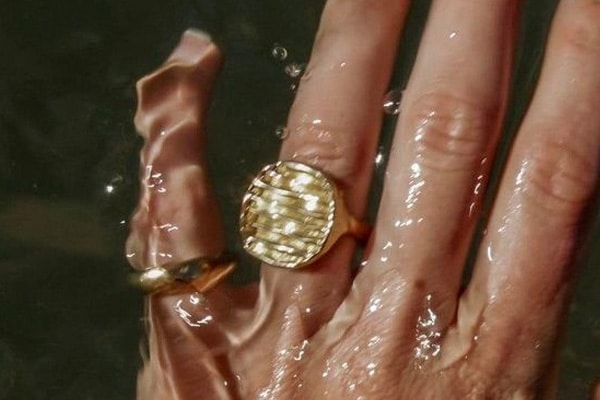
While some people have the notion that solid gold should come in yellowish or golden color, it can come in various shades, but the common ones are yellow, white, and rose.
You can choose any color and have your solid gold jewelry customized to your preference. However, the most popular option is 14K yellow solid gold. It offers the perfect combination of color depth, strength, and affordability, making it a good option to withstand the harshness of salt water.
Platinum Jewelry
Platinum is a natural, appealing, and shiny precious metal that’s gradually growing in popularity in the jewelry industry. It’s unique and rare. In fact, it takes almost 10 tons of ore to make 1 ounce of platinum. And it’s so exclusive that only about 90 tons of platinum are manufactured into jewelry every year as compared to gold that uses 2,700 tons. Hence, why it’s very expensive.
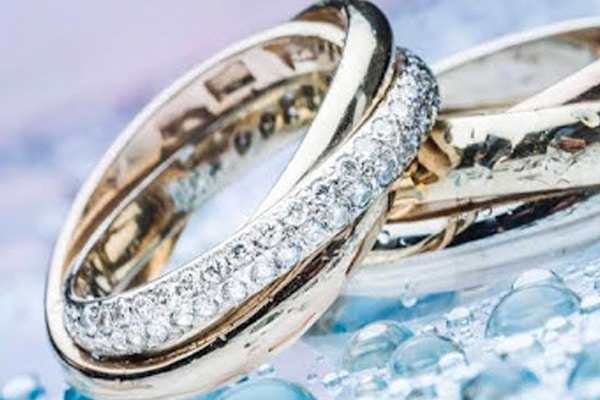
In addition to being more exclusive, platinum is stronger and heavier than other metals, making it a preferred choice for use in the ocean, as it has more capacity to withstand saltwater elements. Also, its strength makes it the ideal option for setting gemstones, especially expensive and natural stones like diamonds on engagement rings. The durability of platinum is sometimes used as a symbol of love indicating companionship that will last forever.
Furthermore, platinum is scratch-resistant, which prevents it from tarnishing or losing its sparkle. This metal is used to make different types of jewelry that can be trusted to survive the extreme conditions of the ocean. This includes platinum chains that are more long-lasting than their sterling silver and gold counterparts, as well as high-end wristwatches that are beautiful and heavier than traditional steel cases and bracelets.
What is the Best Jewelry to Wear in the Ocean
Looking for the most suitable jewelry to wear in the ocean, these are the 3 recommendations we trust to fulfill your demands:
- Platinum: Amongst all the various jewelry types, those made with platinum are the best due to their inert strength and durability. While platinum jewelry is expensive, its alluring appearance, sophistication, and scratch resistance make it the most ideal option to trust for every ocean dive.
- Sterling Silver: Made of pure silver and copper, which are two incredible materials that don’t rust even when exposed to water. Also, these materials are reflective, ensuring that your sterling silver jewelry is attractive despite exposure to saltwater. Unlike platinum, it’s not expensive, hence even if your jewelry gets tarnished, you can easily replace it.
- Gold-Filled: While solid gold is super attractive but very costly, gold-filled steps in the gap. It isn’t just inexpensive, it’s visually appealing, strong, and capable of withstanding tough conditions. Also, it’s very easy to find, as it’s made by heating and bonding molten pure gold on brass. So, in the case that your gold-filled jewelry gives up when exposed to salt water for a very long time, you can easily replace it without breaking the bank.
Key Takeaway
Wearing jewelry in the ocean without worries can be exciting, as your focus will be on celebrating the sea’s beauty and expressing your style. But this can only be achieved by choosing jewelry made with materials that are safe from the consequences of salt water. Some of these materials are platinum, sterling silver, gold-filled, and solid gold.
Remember, the ocean is full of treasures and adventurous, your jewelry shouldn’t stop you from having this experience. Contact us today to help you design durable jewelry pieces that will continue to sparkle and last long despite frequent use in the ocean.
